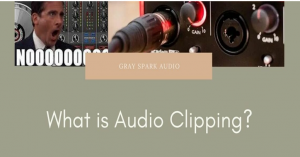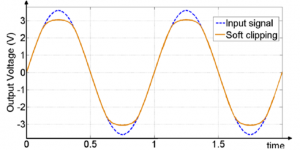
We’ve all heard the word and know about its horrible act of making the sound bad, but do we really understand what it is? As told at every audio engineering course as a rule of thumb is to never record a signal so hot that it redlines. Sound trim is often referred to or associated with red-lining. Let’s get into the awesome “Audio Clipping”.
So what is Audio Clipping? Every machine has a limit, if you try to push it beyond the limit you may fail. Cutting audio is a type of failure, not caused by a machine error but by a user error. An audio clip occurs when you drive too much audio equipment beyond the intended volume. In order to understand what Audio clipping really is, you will need to understand “Sine Wave”.
All Clipping is not bad. If it sounds bad then of course it is, but if used in the right way it can also sound good. Over-driving one’s equipment is never a good idea, and will definitely eat into the life of your equipment, but do it correctly and it will give you the desired outcome that can be considered good for your audio listening experience.
Sine Wave:
Considered sound structures, the Sine wave is a pure form of sound. It is how we represent sound as a mathematical graph. In fact, it describes the smooth oscillation of a constant amplitude.
The sound actually does not move in a wave-like manner, spreading it in all directions evenly if it is not blocked, such as circulating air pressure and generally loosening the pressure as you proceed from the source. However, this is not possible to draw. Therefore, it is represented as a Sine wave in 2D by graph; taking into account distance, time and energy.
The Graphical Introduction below will help you visualize the Sine wave form.
The Sine wave has 3 main characteristics:
Frequency:
the number of times the wave occurs. The rate of repetition of a wave, measured in cycles per second. Called Hertz or (Hz).
Note: Frequency and wavelength are inversely proportional. Lower the frequency and the larger the wavelength. (λ =1/f)
Amplitude:
is the loudness or softness of a sound. It is the pressure of sound, measured in Decibels (dB). The height of each wave from 0db defines the Amplitude.
Phase:
An angular measurement of the time difference between two similar waveforms (expressed in degrees).
See the sine wave this is what we want for our sound output, a smooth and clean flow. Here the signal is undisturbed and indicators on the metering units of the audio equipment such as a mixer would be in the green or amber zone.
Now if one is to start to overdrive the signal or in layman’s terms increase the amplification to a point the equipment can no longer handle the output, then the indicators on a mixer would start to touch red and that is when clipping occurs.
Audio Clipping
Audio Clipping is basically a form of distortion of the waveform. It occurs when an amplifier is pushed beyond its maximum limit, causing the signal to get distorted. Here the drivers are pushed to produce an output voltage beyond their capability. The result is a noisy and unpleasant output.
The sine wave here is cut-off from the top and bottom or “clipped”, resulting in sound distortion and a squared off waveform. This can occur in two ways: Hard & Soft Clipping.
1. Hard Clipping
Hard clipping squares off the wave completely. Causes more loudness but adds harmonics and most noise or distortion in the sound. It also causes a loss of bass.

Digital clipping is Hard clipping. Most digital equipment has digital limiters that cause this kind of hard clipping. Often an analogy of “hitting a brick wall” is associated with this kind of clipping.
2. Soft Clipping
Also referred to as analogue clipping as it occurs mainly in older analogue gear, where enough headroom allows for smoother sound with less distortion. Here you see the Edges of the clipped waveform rounded off. It gives a smoother, better sound for easier listening. It is less damaging to high-frequency drivers.

Common occurrences of Audio Clipping
All Clipping is not bad. If it sounds bad then of course it is, but if used in the right way it can also sound good. Over-driving one’s equipment is never a good idea, and will definitely eat into the life of your equipment, but do it correctly and it will give you the desired outcome that can be considered good for your audio listening experience.
Recording Industry and the Loudness war.
While recording, clipping is used as an effective way to increase the loudness of Audio. Since the advent of CD’s the recording industry has been increasing the master levels of audio using clipping & compression to make the average loudness of audio even louder. Referred to as the loudness war; where through the ages, music has been getting louder and louder. This results in overdriving audio equipment to result in forced clipping in extreme cases. The Loudness war peaked in 2005 and since then normalization of music and comfortable loudness has been pushed especially through online music distribution platforms.
Distortion on a guitar
Distortion on an Electric guitar is caused by overdriving the inbuilt amplifier to add harmonics and give a distorted effect. This intentional overdrive in the guitar amplifier in order to get the desired sound is a perfect example of audio clipping used in a good way.
Redlining on a mixer
Increase the output of the mixer to a point causing the indicators to move out of the green and amber zone, into the red. Redlining adds noise & distortion caused due to clipping. It is never good to overdrive the inbuilt pickups or amps in a mixer, especially newer digital ones as this would result in hard clipping. In a mixer, apart from channel fader controlling the levels of input into each channel, each channel has Hi’s Mid’s and Low end level controls apart from a channel gain, which controls the overall loudness of the audio output of the channel. Additionally, there is also a master gain which controls the total output of the mixer. This way the mixer has multiple levels of control to adjust audio input and output and avoid clipping. A technique well learnt at Audio Engineering Course Pune.

